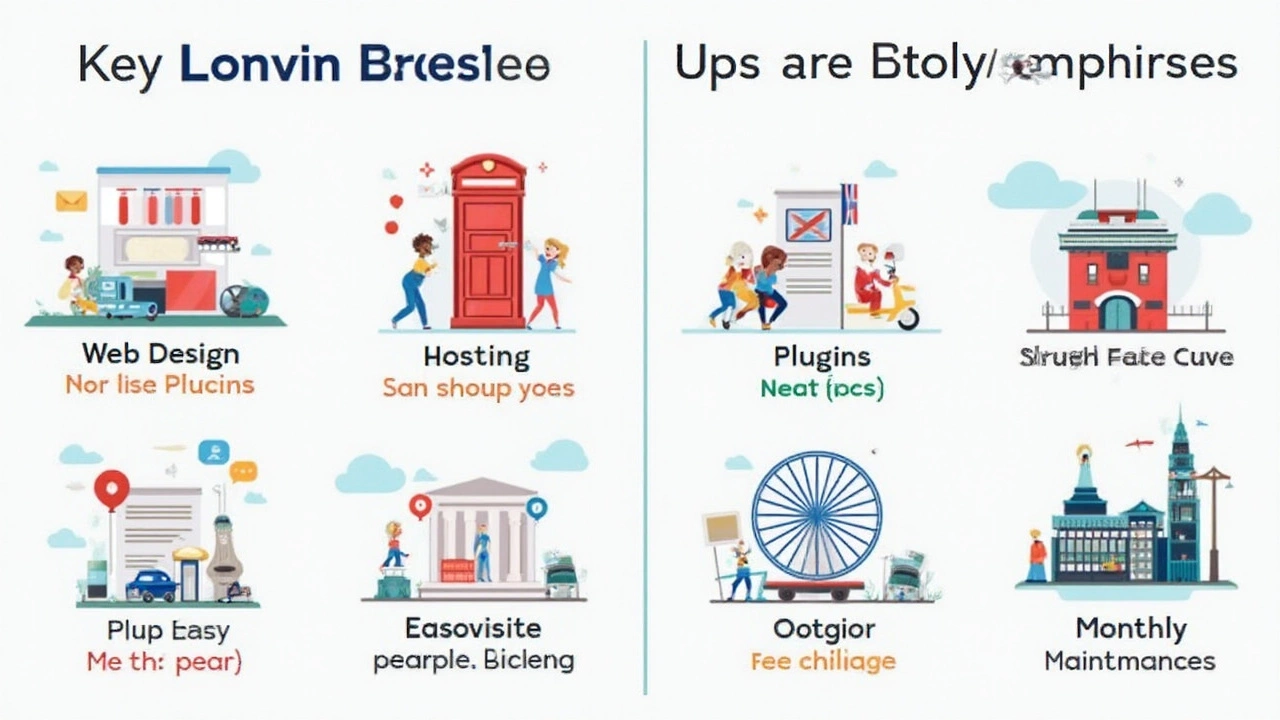Sticker shock hits fast when you see the real price tag of an eCommerce website. A few bucks for a domain? Sure. But a fully working online store? That’s a different story.
Before you jump in, get clear about where your money will actually go. Domain names, hosting, platform fees, design, payment processing—it all adds up. Some people get burned thinking it’s just a couple of hundred dollars to get started, only to run into all kinds of other costs they didn’t see coming.
If you’ve ever wondered, "Can I get away with the cheaper options?" or "Why did my 'simple' store end up costing so much?"—this guide’ll clear things up. I’ll dig into the numbers, call out hidden charges, and give you tips for stretching your budget without ending up with a clunky, broken site.
- What Costs Come with Starting an eCommerce Website?
- Monthly and Ongoing Maintenance Fees
- Where Can You Save—And Where Shouldn’t You?
- Hidden Fees That Catch People Off Guard
- Tips: Cutting Costs Without Sacrificing Quality
What Costs Come with Starting an eCommerce Website?
The moment you decide to sell online, the meter starts running. At first glance, you might just see a few obvious charges—but let’s break down the real grocery list of costs you'll hit on day one.
- Domain Name: The website address. Basic domains usually run $10–$20 per year. Premium names, especially if you want a popular .com, can hit a few hundred dollars or more.
- Web Hosting: This is what gives your website a home. Shared hosting starts as low as $4 a month, but serious eCommerce shops usually go for managed hosting ($30–$100+ monthly) for faster speeds and better security.
- eCommerce Platform Fees: Platforms like Shopify, BigCommerce, and Wix charge monthly. Shopify starts at $39/month; BigCommerce is about the same. WooCommerce (on WordPress) is "free" but you still pay for hosting, plugins, and a theme.
- SSL Certificate: You need this to keep your customers’ info safe and to show Google you’re legit. Some hosts include SSL for free, but standalone certificates run from $10 up to $150 per year for higher-end options.
- Design and Development: Want a custom look or extra features? DIY templates can be free to $180. Hiring a designer or developer jumps from $500 for a basic setup up to $5,000+ for a customized build.
- Payment Processing Setup: Stripe, PayPal, and friends don’t charge setup fees but will take about 2.9% + 30¢ per transaction. Watch this number—it adds up fast with volume.
- Apps & Add-ons: Things like live chat, advanced shipping, reviews, or email marketing might be extra. Most basic add-ons fall in the $5–$50/month range, but some tools cost way more if your store gets busy.
Let’s see what this looks like lined up for a typical small-to-mid-sized online store in 2025:
| Startup Cost Item | Typical Cost (USD) | Frequency |
|---|---|---|
| Domain Name | $10–$20 | Yearly |
| Web Hosting | $4–$100+ | Monthly |
| eCommerce Platform | $0–$100+ | Monthly |
| SSL Certificate | $0–$150 | Yearly |
| Design/Development | $0–$5,000+ | One-time or As needed |
| Payment Processing Setup | 2.9% + 30¢/transaction | Per Transaction |
| Apps/Add-ons | $0–$200+ | Monthly |
If you’re comparing the eCommerce cost and debating where to cut corners, at least now you know what’s actually on the bill from day one. These are the basics—anything extra (like premium marketing tools, custom integrations, or advanced support) gets added on top.
Monthly and Ongoing Maintenance Fees
People often forget that launching your store is just the start. Ongoing costs can stick around for years, and if you don’t plan for them, you could end up in the red. While every store is different, here’s what most shop owners pay for each month:
- Hosting fees: Expect to pay anywhere from $5 to $80+ a month depending on the type of hosting and store size. Managed eCommerce platforms (like Shopify or BigCommerce) include hosting in their plans, but hosting your own WooCommerce or Magento store means separate costs.
- Platform or subscription fees: Shopify, for example, starts at $39/month for its basic plan, while Wix eCommerce starts at $27/month. These usually cover site security, updates, and support.
- Payment processing fees: PayPal, Stripe, and card payments almost always take a cut—usually 2.9% + 30¢ per sale in the US. This fee stacks up fast as your sales climb.
- Software/app/plugin subscriptions: Want better SEO, a faster checkout, or fancy shipping calculators? Most apps or plugins (like Yoast SEO, Klaviyo, or ShipStation) start around $10–$30/month each, and advanced tools can be even pricier.
- Security and backups: Paid SSL certificates, extra security plugins, and automated backups might run another $5–$20/month for self-hosted sites.
Here’s a quick breakdown to keep things straight:
| Monthly Cost | Low-end ($) | High-end ($) |
|---|---|---|
| Hosting/platform | 5 | 80+ |
| Platform subscription | 27 | 399 |
| Payment processor fees* | 2.9% + 0.30/sale | 3.5% + 0.49/sale |
| Apps/plugins | 10 | 200+ |
| Security & backups | 5 | 20 |
*Fee depends on sales volume and provider.
Don’t ignore these ongoing expenses when working out your eCommerce cost. Skipping regular backups or security subscriptions might sound like a money-saver, but all it takes is one hack or crash to wipe out your site—or business. Always budget a little extra for plugin updates and support, since things break over time.
If you’re running marketing (email or ads), factor in those monthly costs too, even if they’re not technically “site maintenance.” Every dollar counts, especially once your store is live and real customers rely on you.

Where Can You Save—And Where Shouldn’t You?
There’s a ton of advice out there about trimming your eCommerce cost, but some corners are just not worth cutting. Let’s break down the stuff you can go cheaper on—and the few things you really shouldn't skimp.
Go ahead and save on template designs. You don’t need a $5,000 custom theme when plenty of pre-built options go for $50 to $200. For most small shops, a good-quality template looks sharp and has everything you need. Even some successful Shopify stores run on basic templates with tweaks. As for initial product photos, a modern smartphone, some natural light, and a clean background work almost as well as renting a studio.
Hosting is where you can sometimes save if you’re just starting out. Shared hosting plans might cost $10 a month or less, and they’re fine if you’re not expecting heavy traffic or crazy spikes during sales. Once business picks up, you can always upgrade to something sturdier.
- Save up front: Choose a template over a custom design, use basic shared hosting, take your own photos, and go DIY for the simple parts (like writing product descriptions and setting up basic pages).
- Don’t cut corners: Payment security and support. Payment processing fees look small, but problems cost way more. If a gateway offers good fraud protection and responsive support, stick with them—even if the rates are a tad higher. The same goes for SSL certificates. Free ones are okay, but if you’re collecting sensitive info, consider a paid one for extra trust and features.
- Don’t cheap out on updates and backups. Automated backups, real-time security scans, and regular site maintenance sound boring, but a hacked or lost site is a nightmare. Always budget for this—even if you have to do it yourself at first.
The table below gives you a direct comparison on what’s usually safe to save on, what isn’t, and the average cost range for each:
| Item | Safe to Save? | Typical Cost Range |
|---|---|---|
| Template Design | Yes | $50 - $200 |
| Custom Design | No | $2,000+ |
| Web Hosting | Yes, if starting small | $5 - $30/month |
| Payment Processing | No | 2.9% + 30¢ per transaction |
| Security/SSL Certificate | No | $0 (basic) - $150/year |
| Product Photography | Yes | $0 (DIY) - $500+ |
| Backups & Maintenance | No | $5 - $20/month |
Avoid the temptation to pick the absolute cheapest options for anything that touches money or user data. But for looks and content, you’re fine starting simple and leveling up when the income justifies it. It’s about spending smart, not just spending less.
Hidden Fees That Catch People Off Guard
Here’s where a lot of first-timers get unpleasant surprises. Planning for a basic budget is smart, but extra charges sneak up fast if you don’t know where to look.
First up: payment processing fees. Every time someone buys from your site, companies like PayPal or Stripe usually take around 2.9% plus 30¢ per transaction. Sell $10,000 in a month? That’s about $290 (plus fixed fees) gone—just for letting people pay you. If you have international customers, expect even higher rates or extra currency conversion charges tacked on too.
Then there’s the cost of add-ons—think apps, plugins, or extra site features. Maybe it’s abandoned cart recovery, real-time shipping calculators, or live chat. These sound small, but $5–$50 per month each can push your budget over the edge. Most aren’t free, and "free trial" versions can become monthly bills before you know it.
Some platforms charge for bandwidth or storage once your site passes certain limits. Big spike in visitors? You could see overage fees, especially with cheaper hosting plans. Images and product videos take up tons of space, and if you don’t compress them, costs climb faster.
Let’s talk chargebacks. If a customer disputes a charge, and the money is sent back, you pay—not just the refund, but usually a chargeback fee, which averages between $15–$25 each time. Get hit with several a month, and that’s real money drained from your eCommerce cost.
Here's a quick rundown of common hidden fees and how much you might pay for each:
| Fee Type | Typical Cost | When It Hits |
|---|---|---|
| Payment Processing | 2.9%+$0.30 per sale | Every sale |
| App/Plugin Fees | $5–$50/mo each | Monthly, per add-on |
| Bandwidth Overages | $2–$10 per extra GB | Highly active months |
| Chargeback Fees | $15–$25 per dispute | Per customer dispute |
| Email Marketing | $20–$200/mo | Scaling audience |
| SSL Certificates | $0–$150/year | Security upgrades (sometimes free) |
One more pitfall: many "cheap" eCommerce platforms lock you in with contracts or tough cancellation policies. When you try to switch to another provider, you could be looking at early exit charges or data export fees.
- Double-check platform fine print before signing up
- Calculate processing fees based on your monthly expected sales, not just per transaction
- Regularly review app/plugin usage—kill anything you’re not fully using
Knowing about these extra costs stops you from blowing your budget. Keep your eyes open, dig into the details before you launch, and the numbers for your eCommerce cost won’t jump out and bite you later.

Tips: Cutting Costs Without Sacrificing Quality
Building an eCommerce website doesn’t mean you have to burn through your budget. But going cheap without a plan usually leads to headaches. Here’s how to slash expenses while keeping things pro.
- eCommerce cost is lowest when you use hosted platforms like Shopify, Wix, or Squarespace. They bundle hosting, security, and updates for a flat fee—usually $29 to $39 a month. Compare that to custom-built sites, which can run into thousands just to start.
- Don’t pay someone big bucks to set up what you can handle yourself. Most themes on popular platforms are plug-and-play, and you’ll find tons of YouTube tutorials for free. Invest sweat before cash.
- Stick to free or low-cost plugins and skip add-ons you don’t need at first. You can always upgrade as your store grows.
- Be picky with paid themes. A one-time $80-$200 for a theme with built-in features will beat endless spending on separate plugins.
- Bundle services. Some tools handle marketing, email, and analytics together, cutting down the stack of individual subscriptions you’d otherwise juggle each month.
Quick tip: Always compare transaction fee rates. Some payment processors charge over 2.9% + 30¢ per sale, which adds up fast once you get rolling. Check out this breakdown:
| Platform | Monthly Fee (USD) | Transaction Fee |
|---|---|---|
| Shopify Basic | $39 | 2.9% + 30¢ |
| Wix eCommerce | $27 | 2.9% + 30¢ |
| WooCommerce (self-hosted) | $10-$30 (hosting) | 2.9% + 30¢ (Stripe/PayPal) |
If you’re using a platform, check what’s included. A lot cover SSL security, updates, and backups. Skip services that upcharge for basics you already get.
Finally, don’t cut costs on things that matter most—like page speed. Slow sites drive away buyers. Invest in decent hosting or a quality platform to avoid losing sales down the line.
- Use free tools like Google PageSpeed Insights and GTmetrix to test your site speed before sinking cash into fancy upgrades.
Avoid being penny wise and pound foolish. Spend where it counts—just skip the extras that don’t help you sell more or run smoother.





